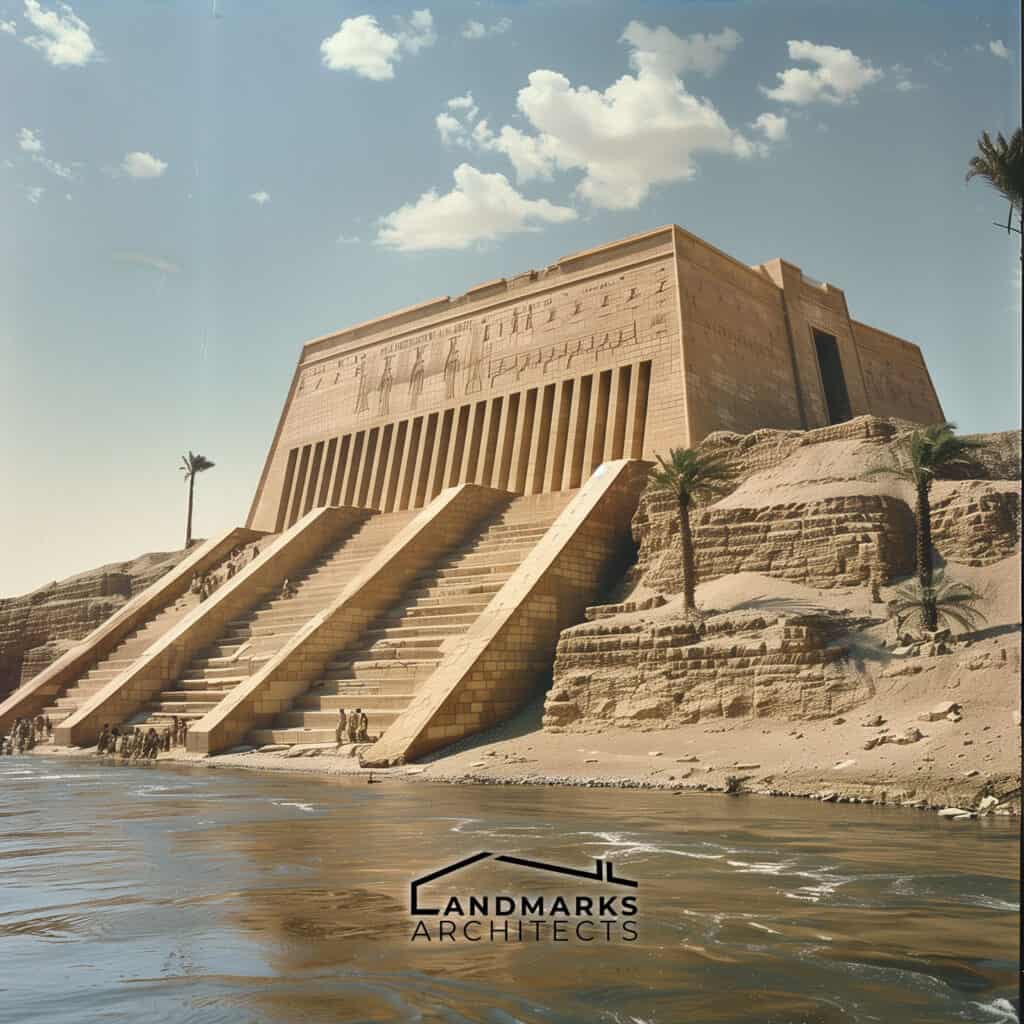

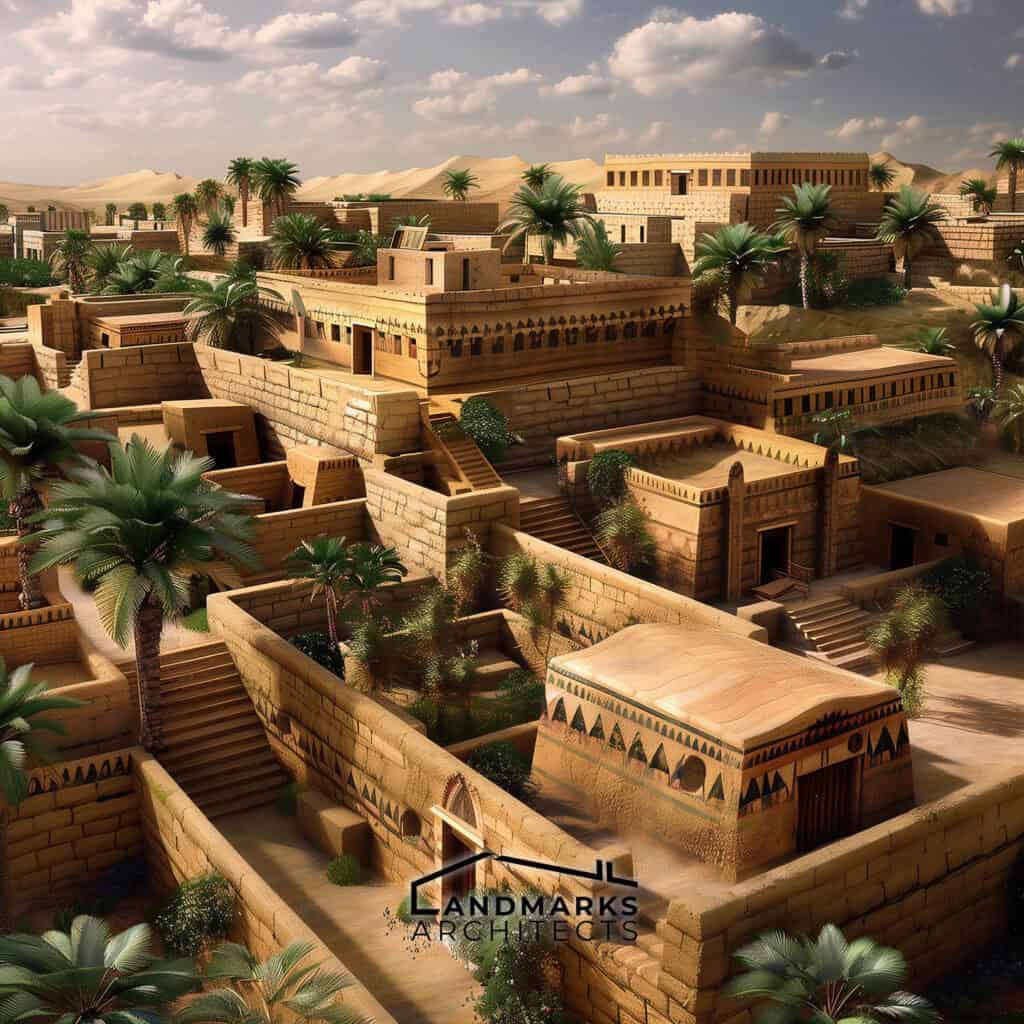

Ever wondered how ancient builders crafted monumental structures with minimal resources? Ancient Mesopotamian architecture, from the heart of early civilization between the Tigris and Euphrates, showcases innovative techniques and impressive designs that have fascinated historians and architects alike.
At Landmarks Architect, we offer an in-depth look into Mesopotamian architecture’s remarkable achievements. With our expertise in ancient history and architecture, we guide you through the key elements of this era’s structures.
In this article, we will explore:
- Core characteristics of Mesopotamian architecture
- Materials and techniques used in construction
- Types of structures, from ziggurats to palaces
- Architectural innovations and their influence
- Notable examples like the Ziggurat of Ur and the Ishtar Gate
Ready to uncover the secrets behind these ancient marvels? Continue reading to discover how Mesopotamian architects’ ingenuity shaped their world and left a lasting legacy.
What is Ancient Mesopotamian Architecture?
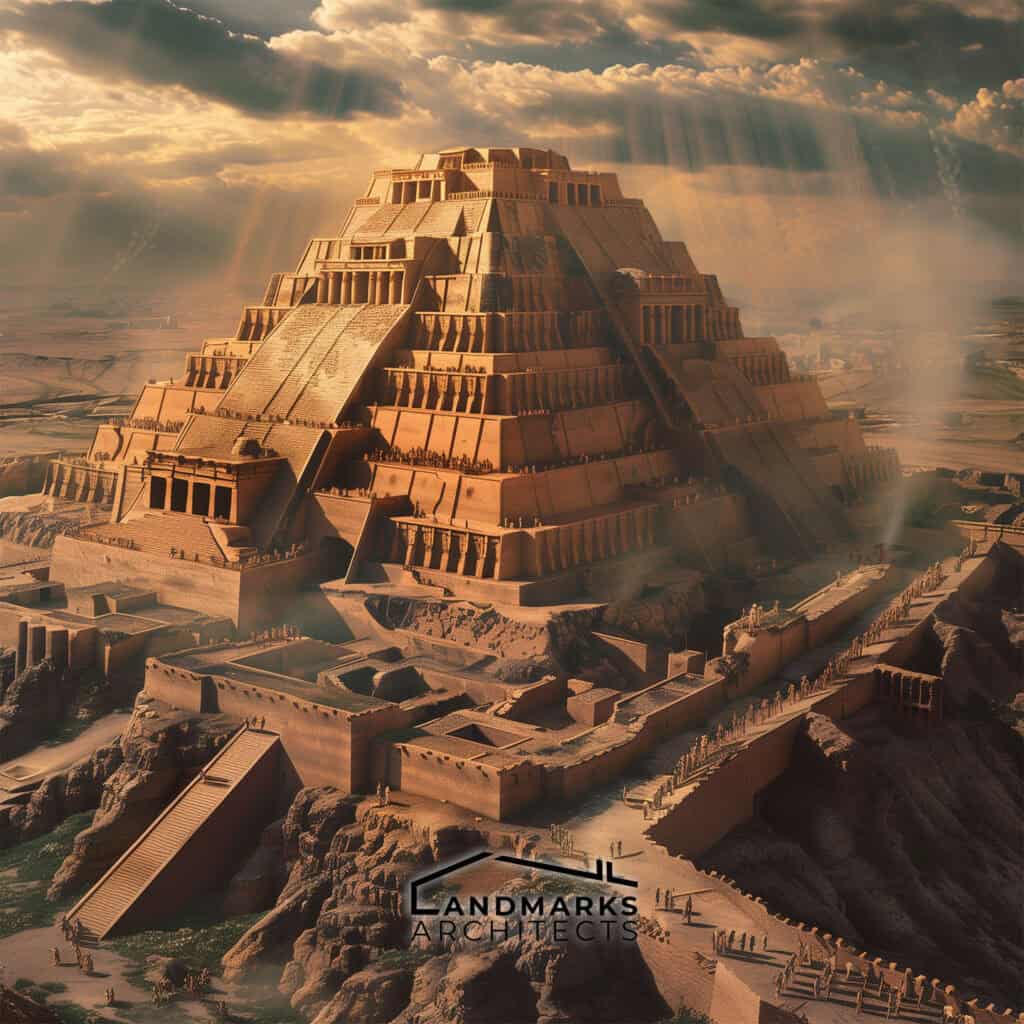
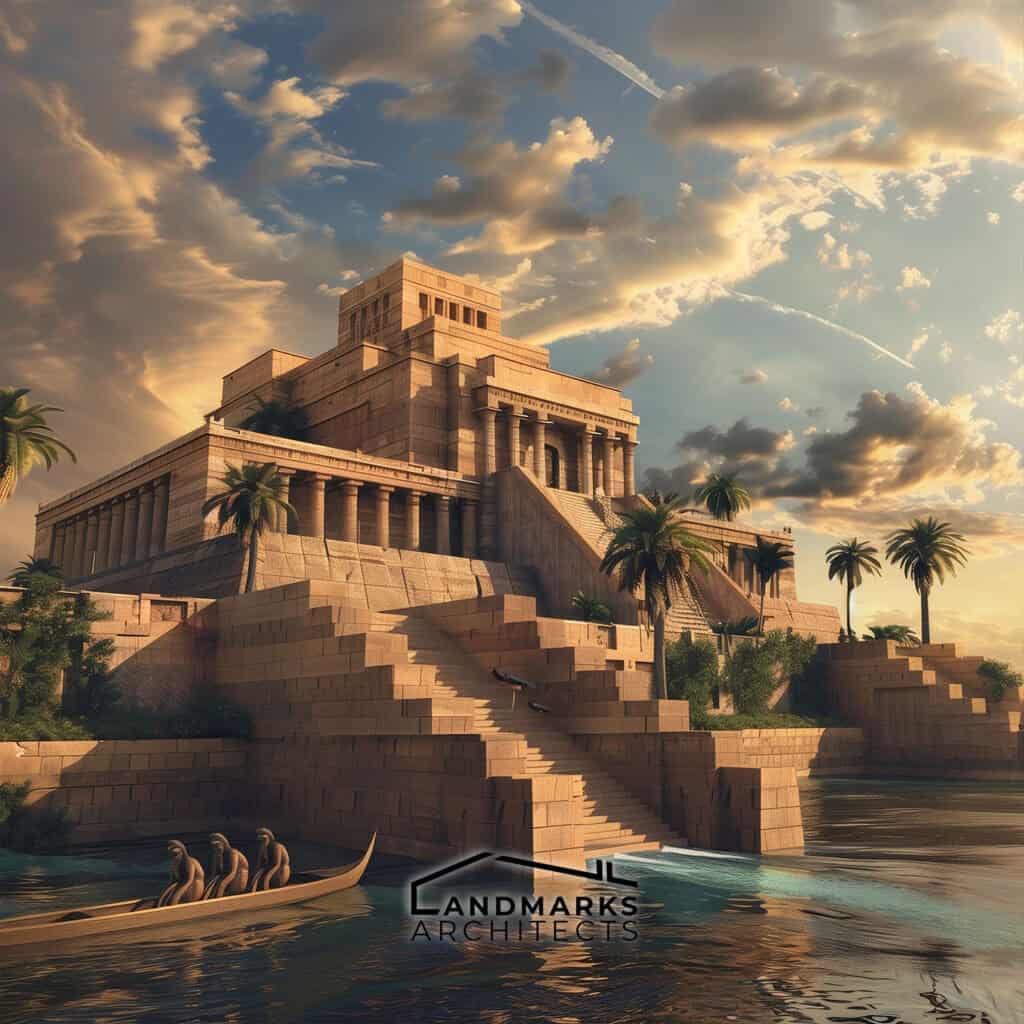
Ancient Mesopotamian architecture refers to the architectural styles and achievements of civilizations in the region between the Tigris and Euphrates rivers, primarily modern-day Iraq.

This architecture began during the Ubaid Period with the construction of early permanent structures. It evolved significantly during the Uruk Period, marked by sophisticated urban planning and monumental buildings.
Key historical periods include the Early Dynastic Period and the Akkadian Period, which are known for their intricate designs and the construction of ziggurats dedicated to various patron deities. The Neo-Sumerian Period further advanced architectural techniques, showcasing developments in construction.
See Also Famous Buildings in Syria
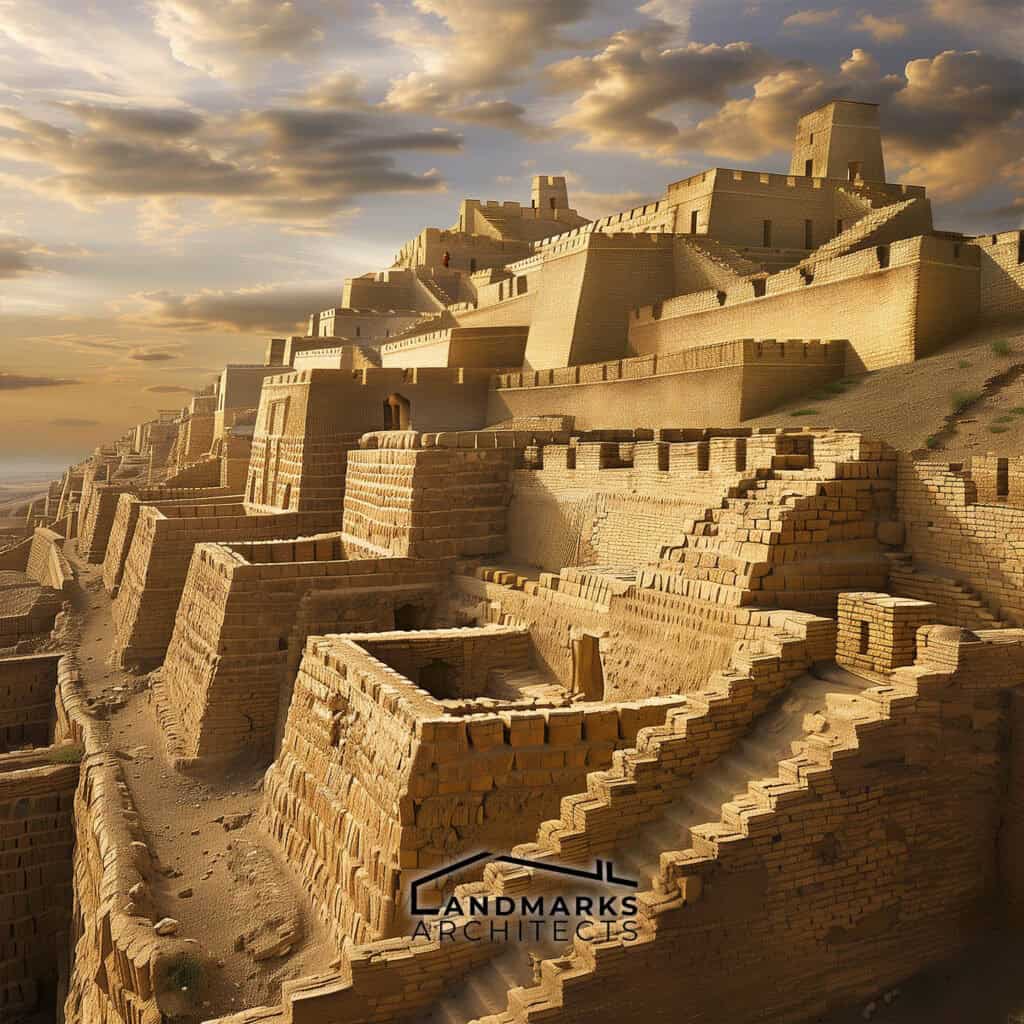
Materials like mudbrick were prevalent due to the climatic conditions of the Early Bronze Age. Architectural features commonly included temples, palaces, and defensive walls, reflecting the religious beliefs and societal organization of Ancient Mesopotamia.

Rich in symbolism, these structures often incorporated elements of Sumerian mythology and used art for both spiritual and political purposes. Mesopotamian architecture is a testament to the ingenuity and cultural dynamics of ancient cultures in the Near East.
Materials and Techniques

Ancient Mesopotamian architecture utilized various materials and techniques to create their impressive structures, showcasing their ingenuity and adaptability.
Materials
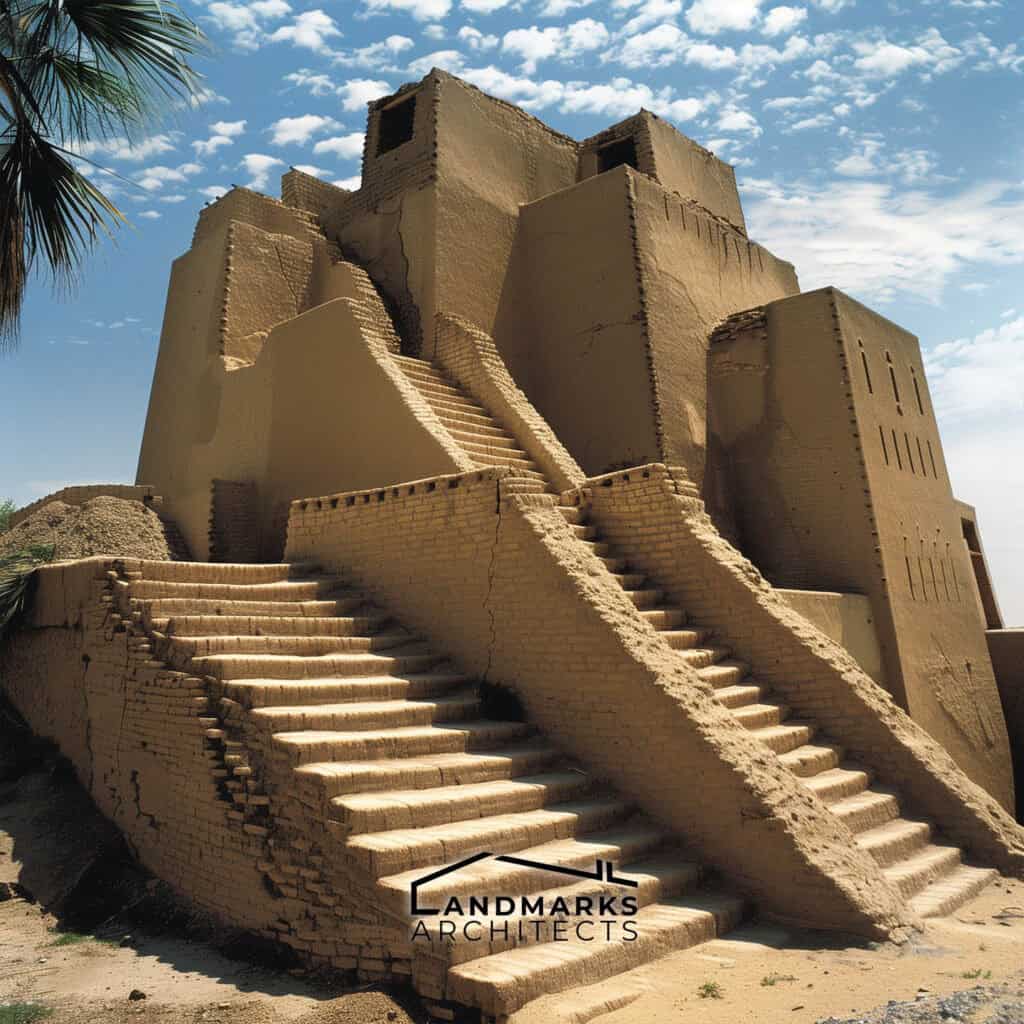
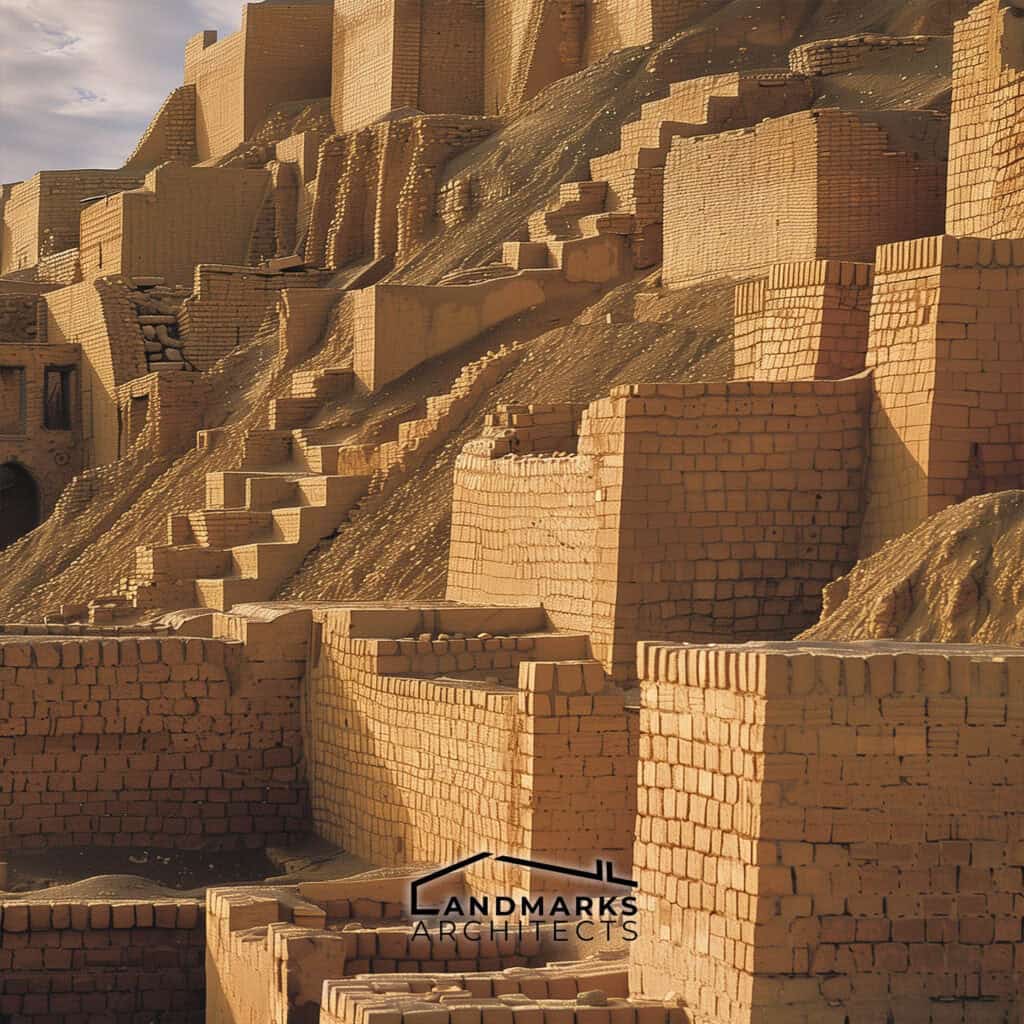
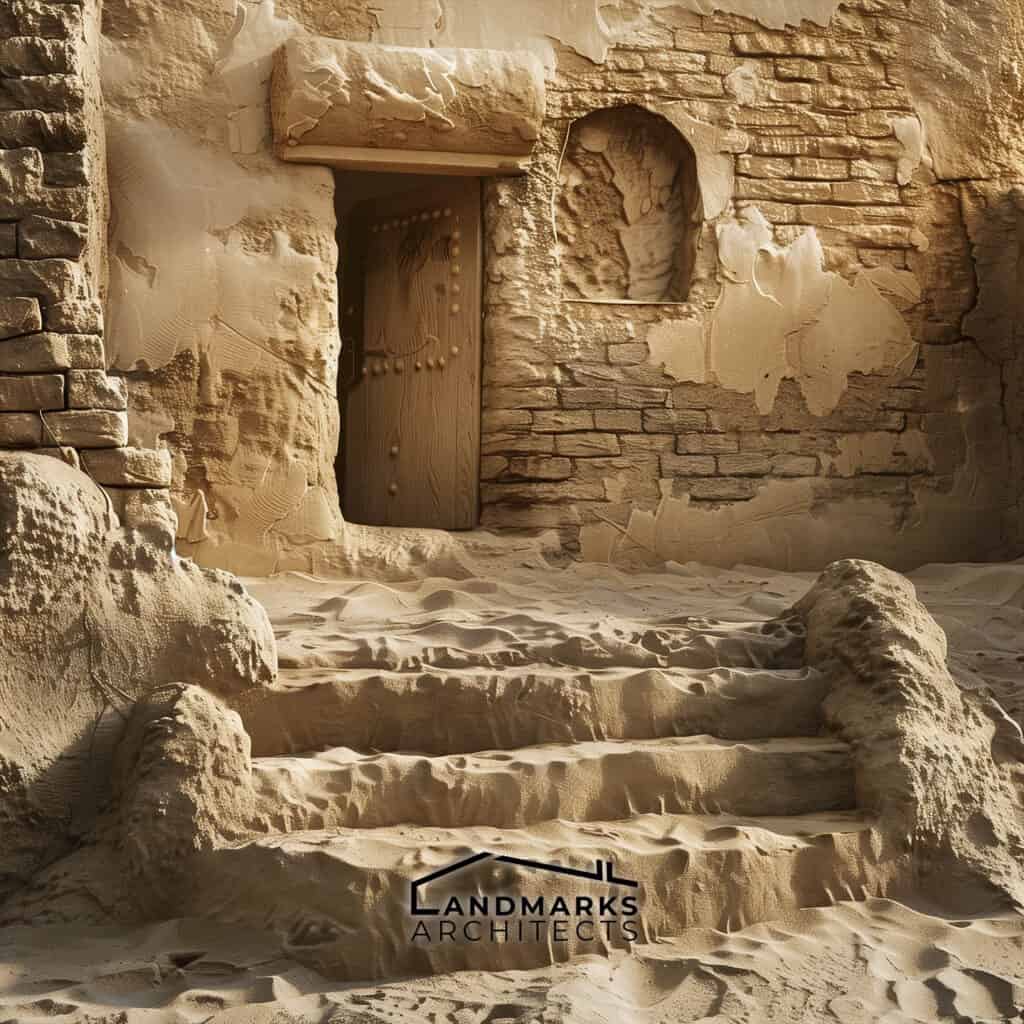
- Mud Brick: The primary building material, made from clay, straw, and water, and sun-dried to create strong, lightweight bricks.
- Sun-Baked Bricks: Fired in kilns for added durability, used in some regions for more enduring construction.
- Mud Plaster: Applied to enhance aesthetics and protect structures from the elements.
- Stone: Used selectively, with durable and hard stones reserved for significant buildings.
- Colored Stone: Utilized decoratively, adding visual appeal to temples and palaces.
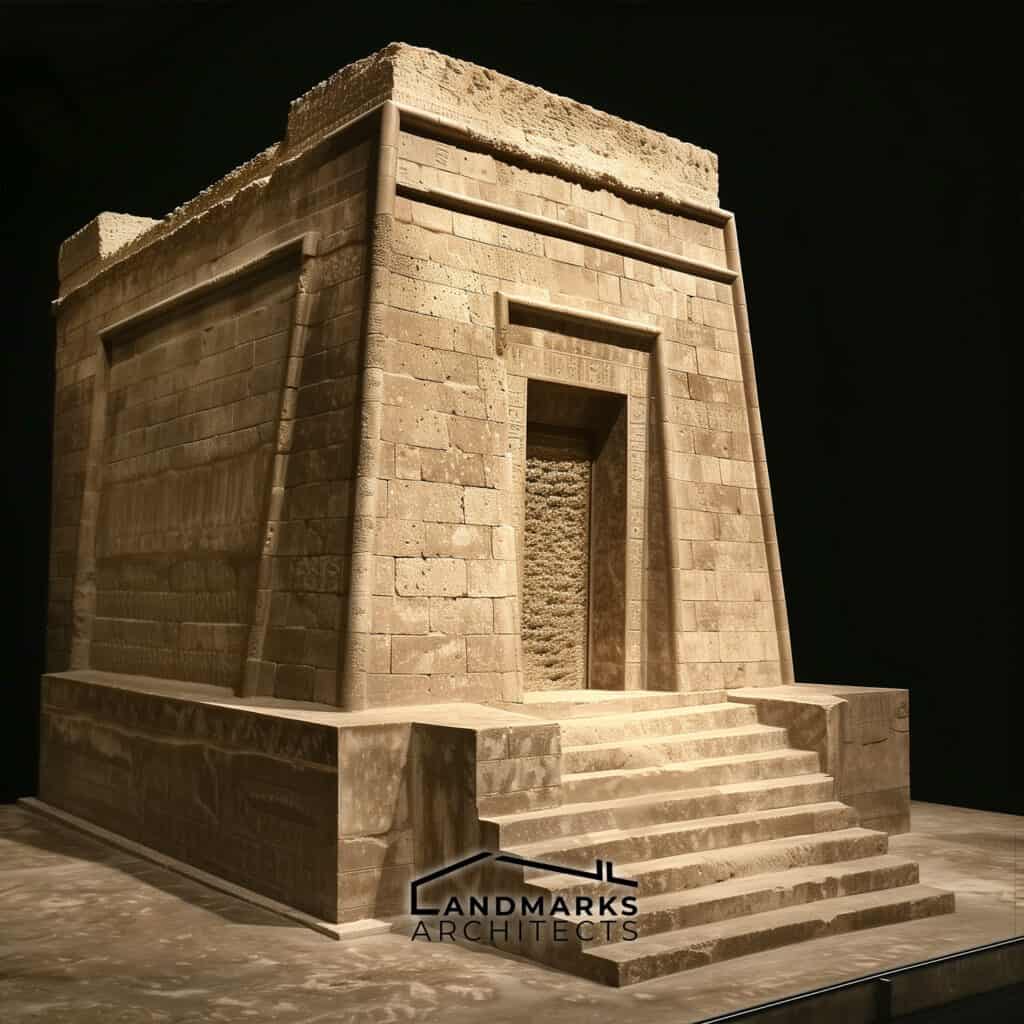
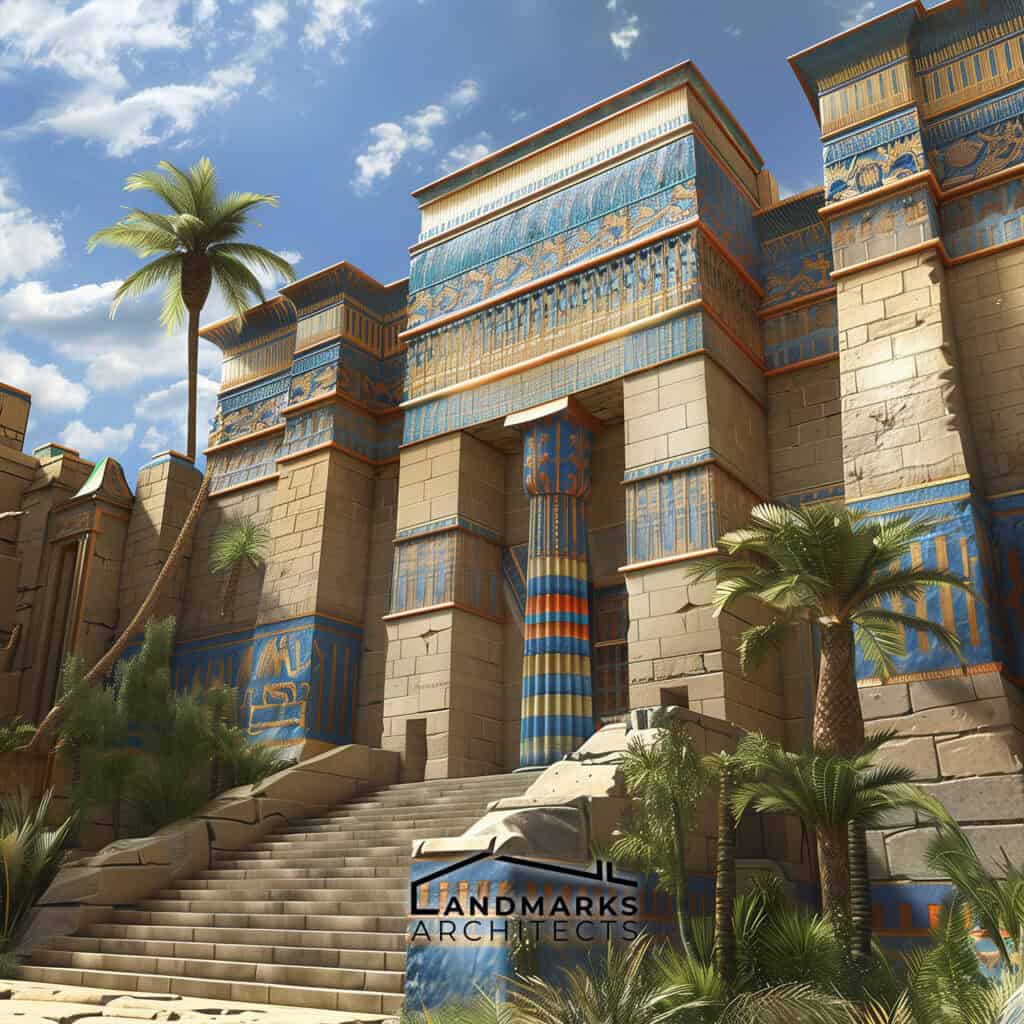
Construction Techniques


Mesopotamian builders employed several innovative construction techniques to enhance the functionality and durability of their structures:
- Thick Walls: Provided stability and insulation, essential for both residential and monumental buildings.
- Flat Roofs: Constructed with wooden beams and layers of mud bricks, these roofs were common in Mesopotamian architecture.
- Arches: Used in gateways and entrances to create broader openings and improve structural support.
- Buttressing: Reinforced walls to ensure longevity and stability.
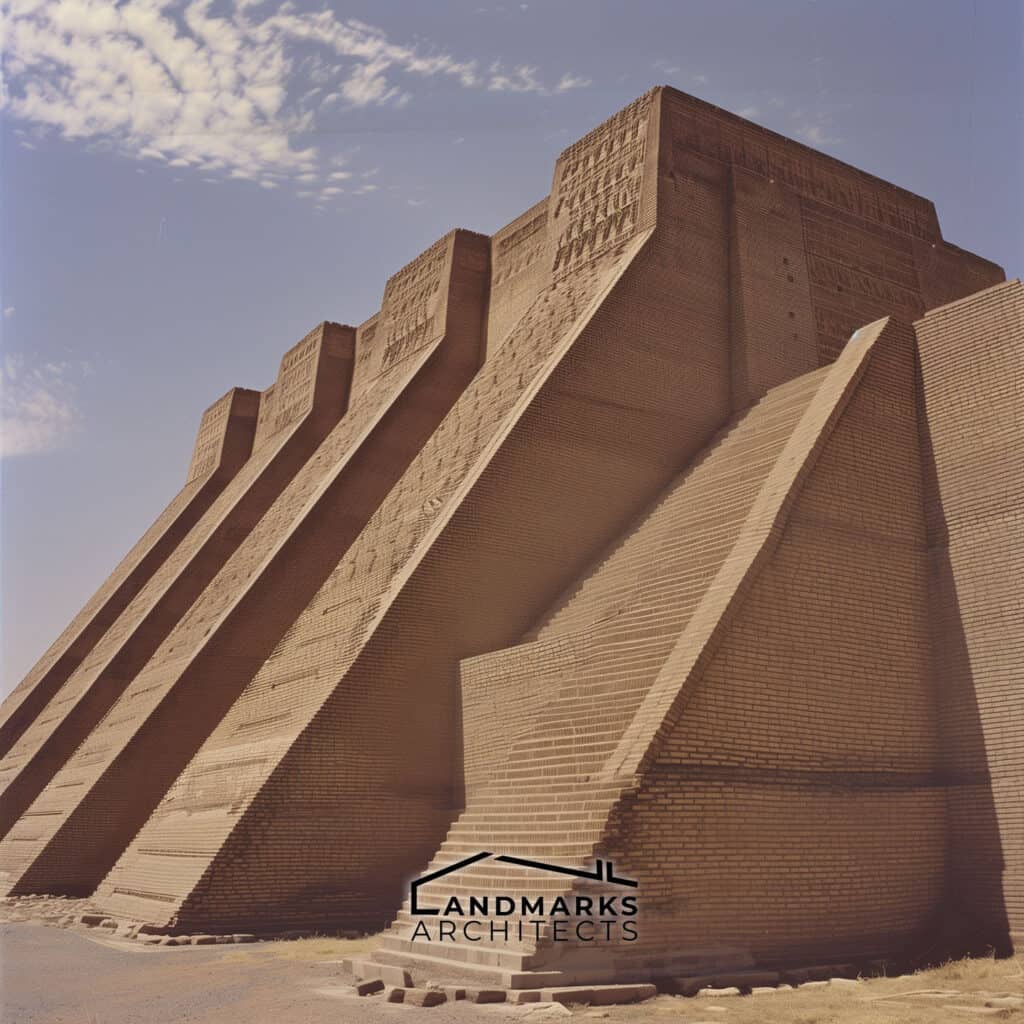
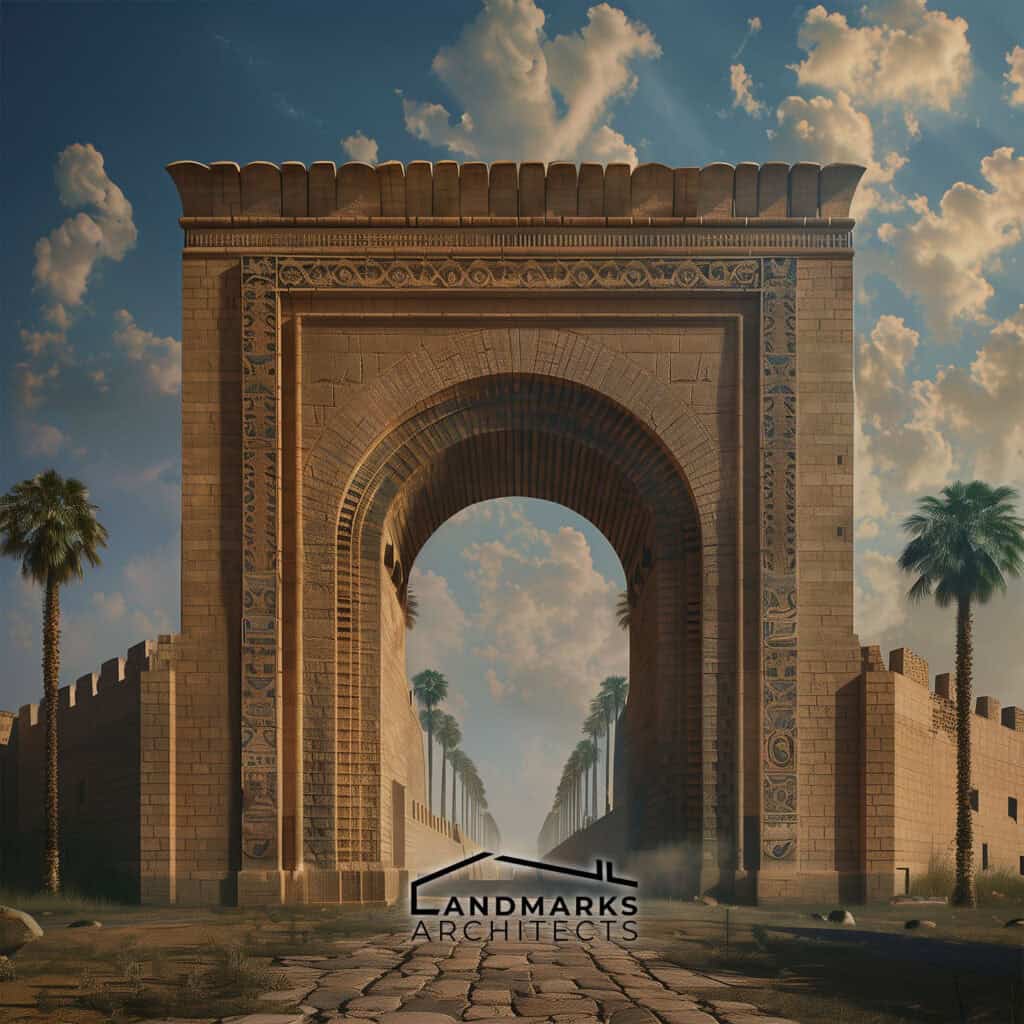
See Also Famous Buildings in Egypt
Types of Structures
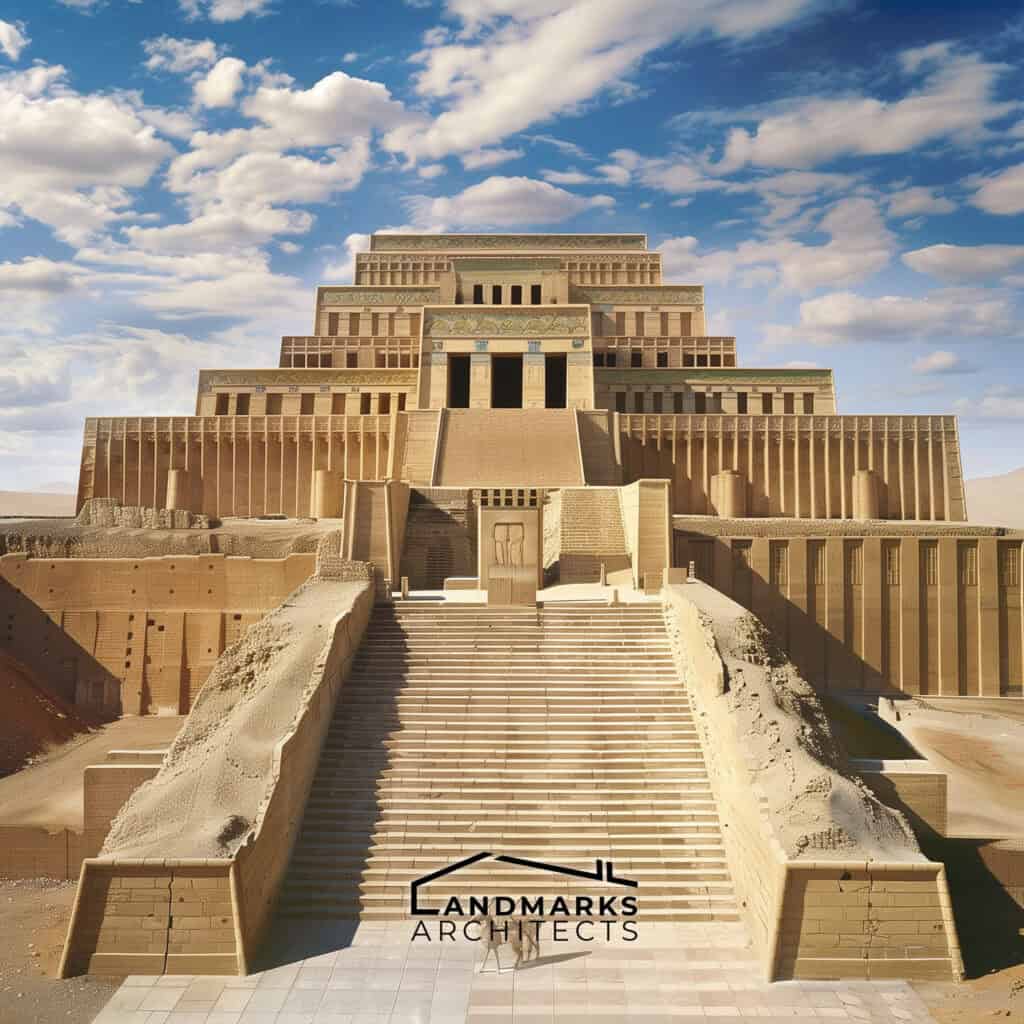
Ancient Mesopotamian architecture includes a range of monumental and domestic structures that reflect the region’s cultural and religious values. Key types are ziggurats, palaces, houses, city walls and gates, and temples.
Ziggurats
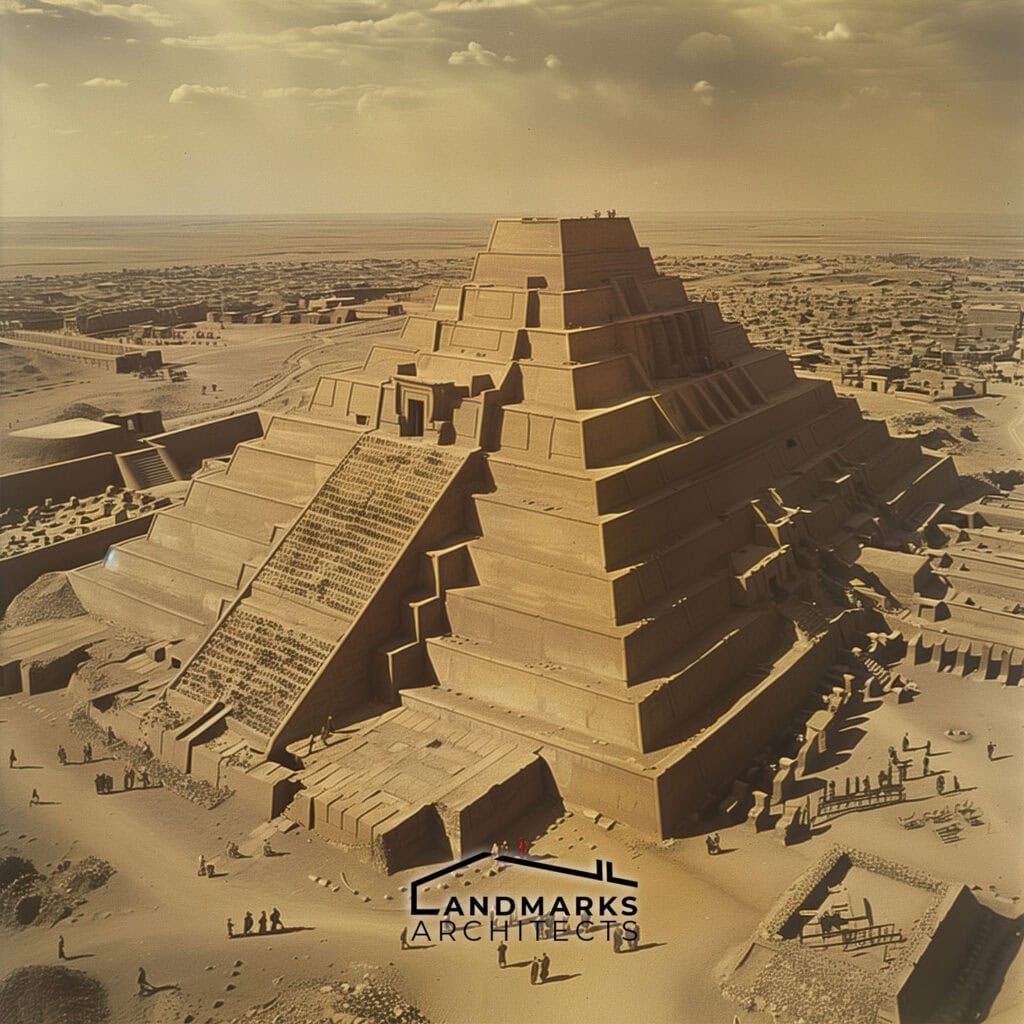
Ziggurats are iconic stepped structures that functioned as religious temples. Made primarily of mud bricks, each level symbolized an ascent toward the gods. The Ziggurat of Ur, dedicated to the moon god Nanna, is a notable example. These structures featured altars and offering areas, playing a central role in urban planning and Sumerian religious practices.
Palaces
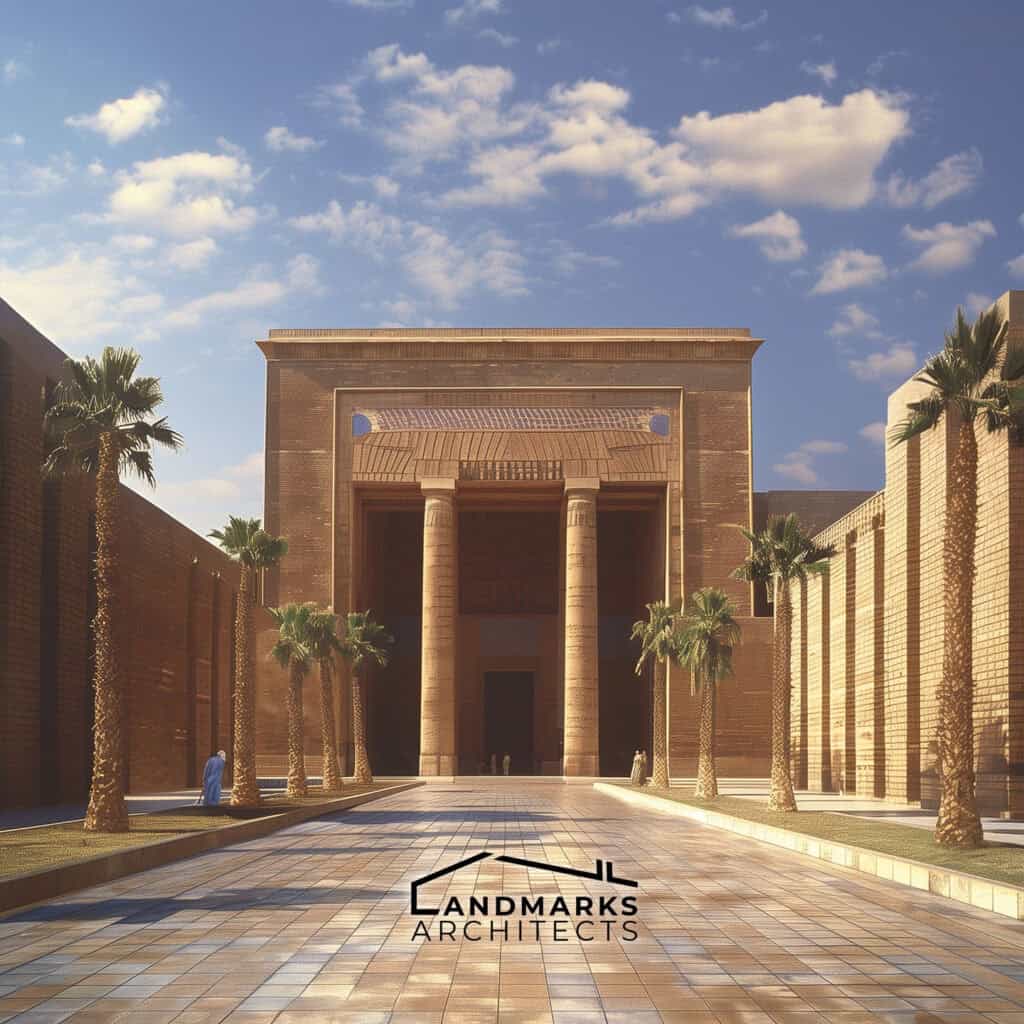
Palaces in Mesopotamia were grand residences and administrative centers, lavishly decorated with large courtyards, intricate wall reliefs, and treasures like lapis lazuli.
Built with sun-dried and baked bricks, they were strategically located near city centers to signify power and authority.
Houses
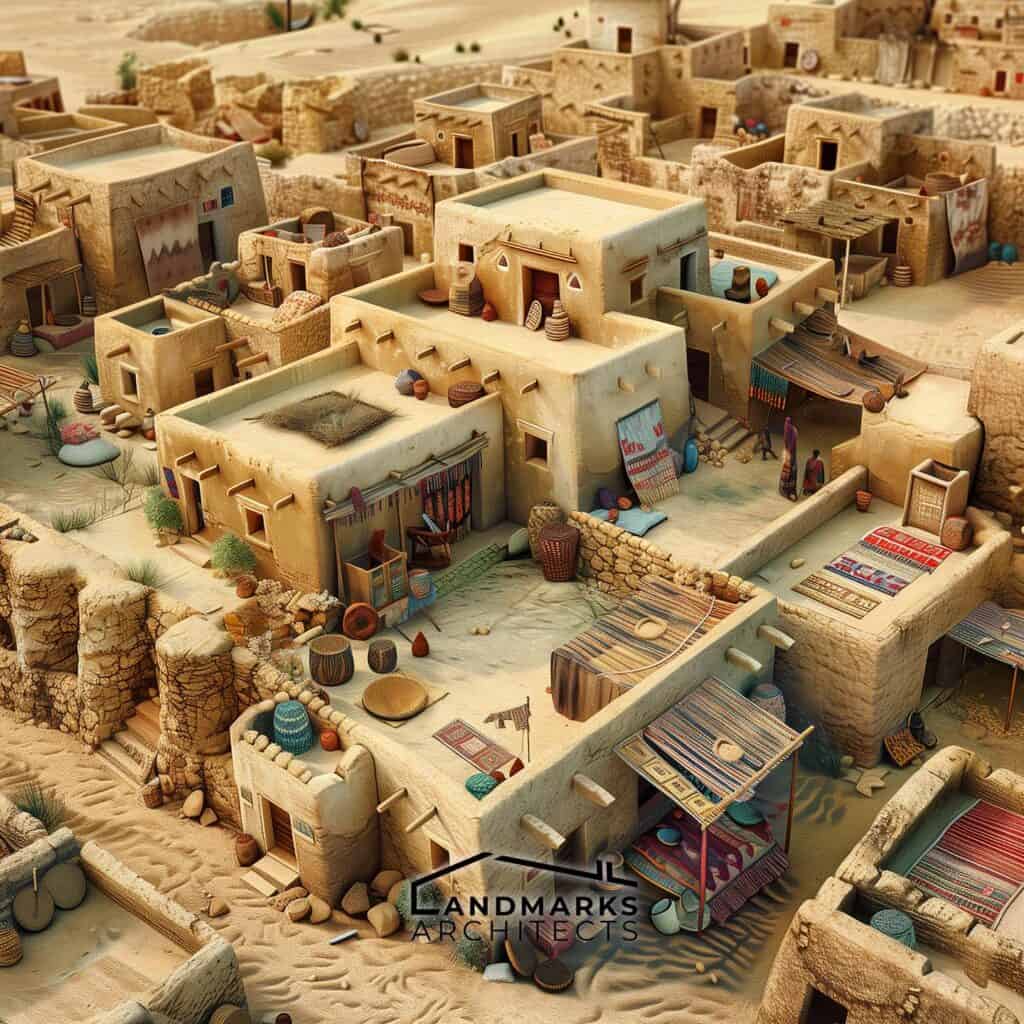
Mesopotamian houses were typically single or double-storied, constructed from mud bricks and featured flat roofs for additional living space. Interiors included small, multifunctional rooms with ground floors used for livestock and storage.
Wealthier families had more elaborate homes with colorful decorations, while simpler houses reflected the majority’s lifestyle.
City Walls and Gates
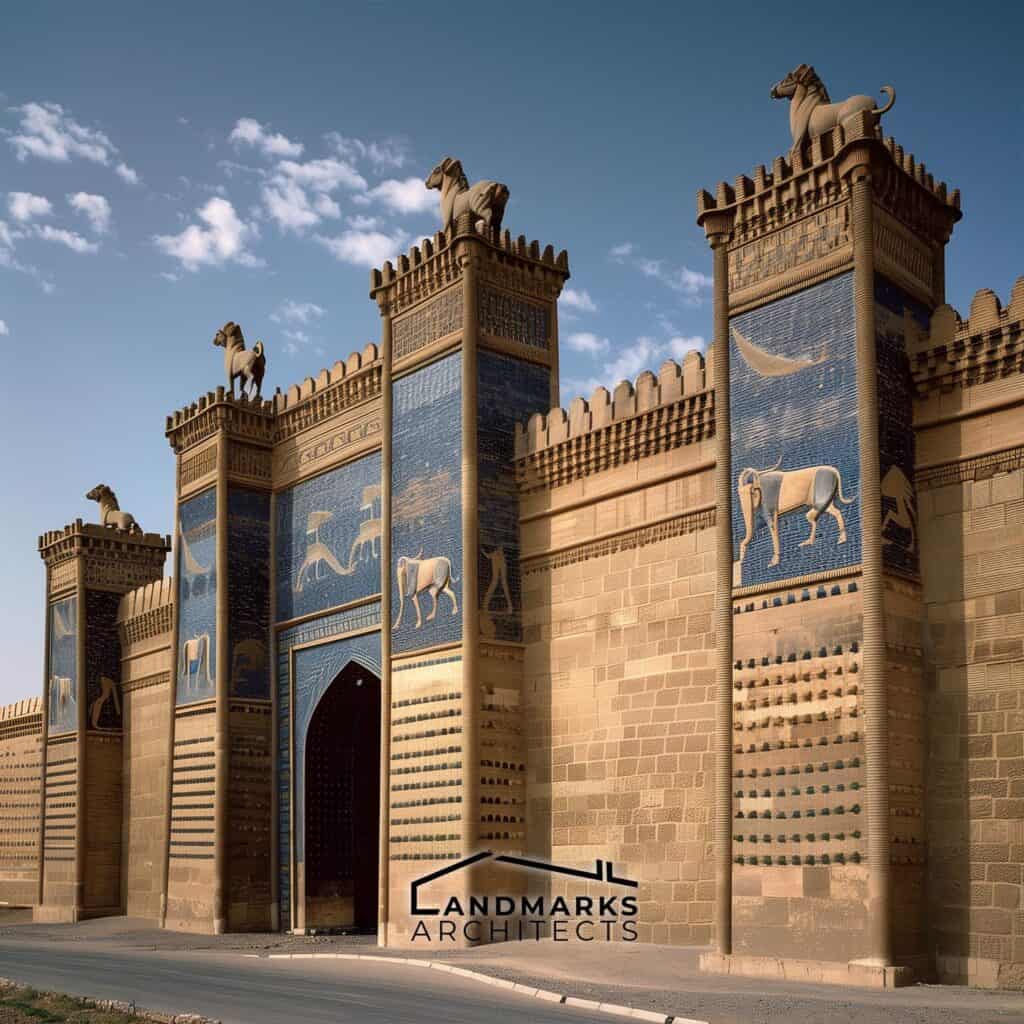
City walls were crucial for defense and symbolized the strength of the city-state. Made from mud bricks and sometimes stone, they were thick and high.
Gates, such as the Ishtar Gate, were both functional and artistically significant, adorned with blue glazed tiles and reliefs of dragons and bulls, showcasing Mesopotamian art and divine protection.
Temples
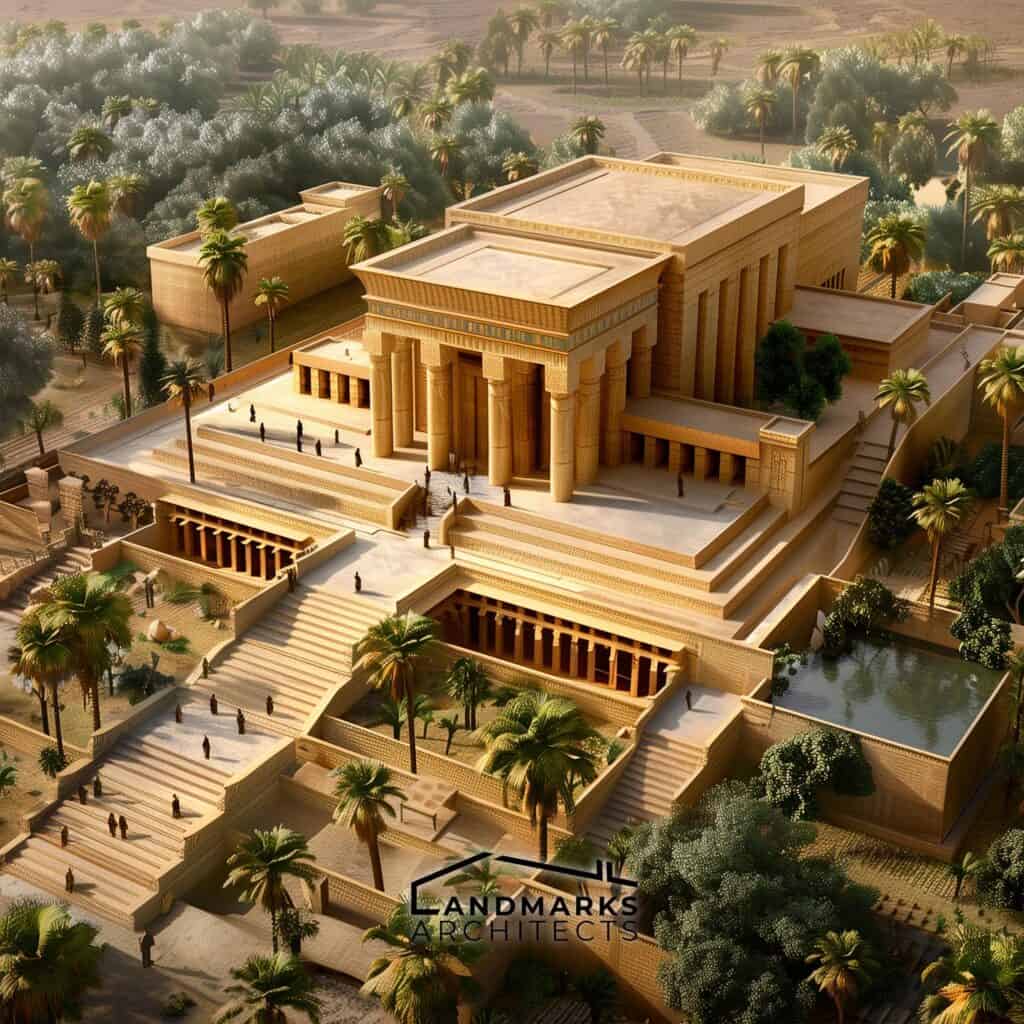
Temples were central to religious life, and dedicated to various patron deities. Often built adjacent to ziggurats, they featured large courtyards and altars for sacrifices.
Temples exhibited monumental architecture and also served economic functions, acting as centers for trade and administration, thus playing a crucial role in the community’s structure.
See Also Famous Buildings in Iran
Architectural Innovations
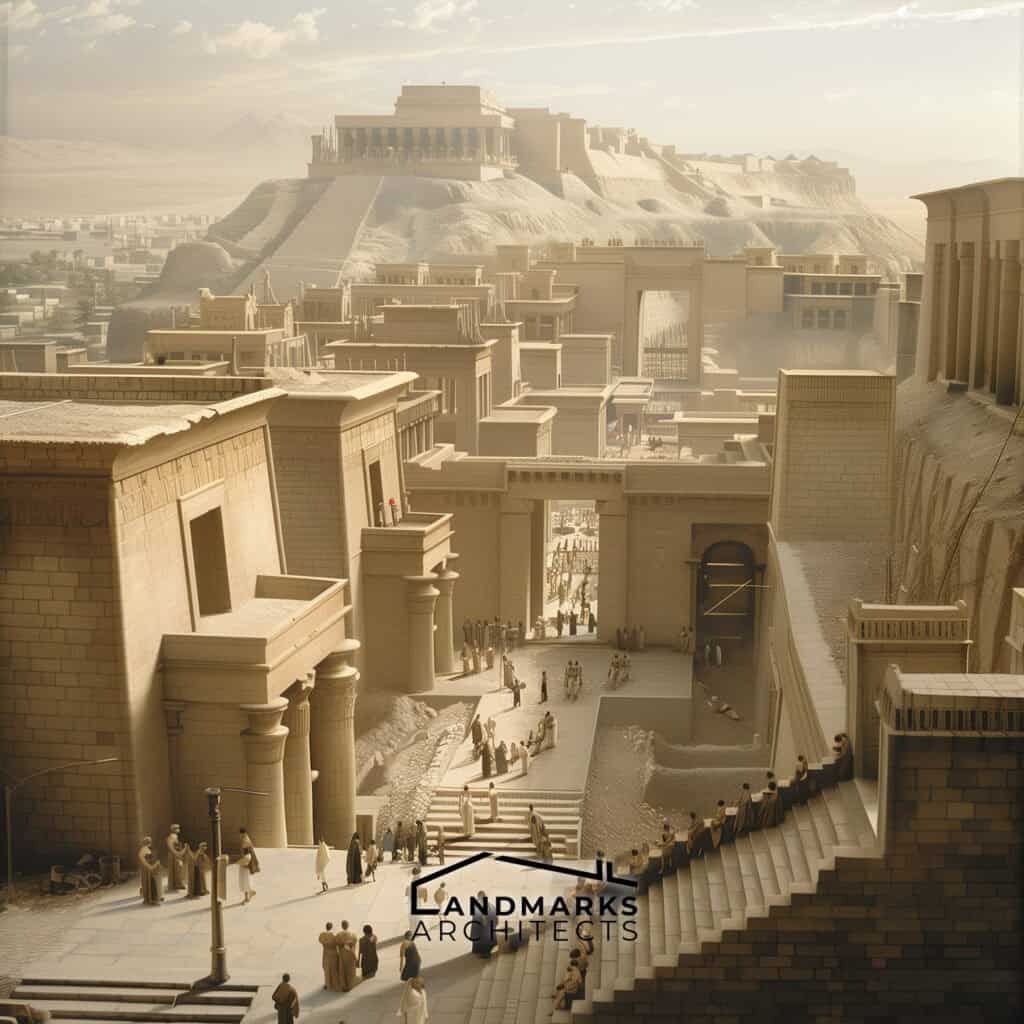
Ancient Mesopotamian architecture is noted for its significant innovations, which greatly influenced urban development and monumental construction. Key advancements include the use of arches and vaults, sophisticated urban planning, and elaborate decorative arts.
Arches and Vaults
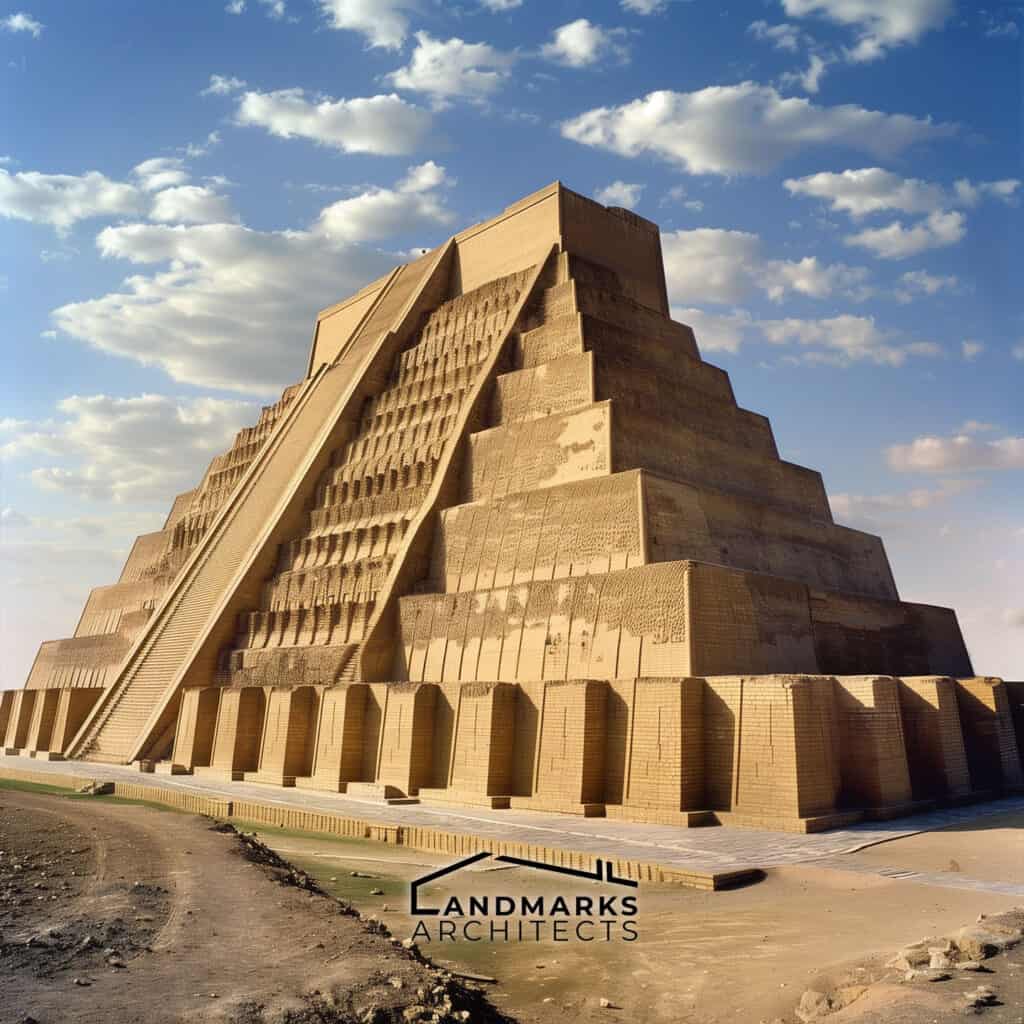
Mesopotamian architects were pioneers in using arches and vaults, allowing for larger and more stable structures. These elements are prominently featured in Sumerian temples and ziggurats, such as the Ziggurat of Ur.
Constructed from mud bricks and often covered in mud plaster, these buildings not only demonstrated architectural ingenuity but also supported grand designs reflecting the significance of the patron deities.
Urban Planning
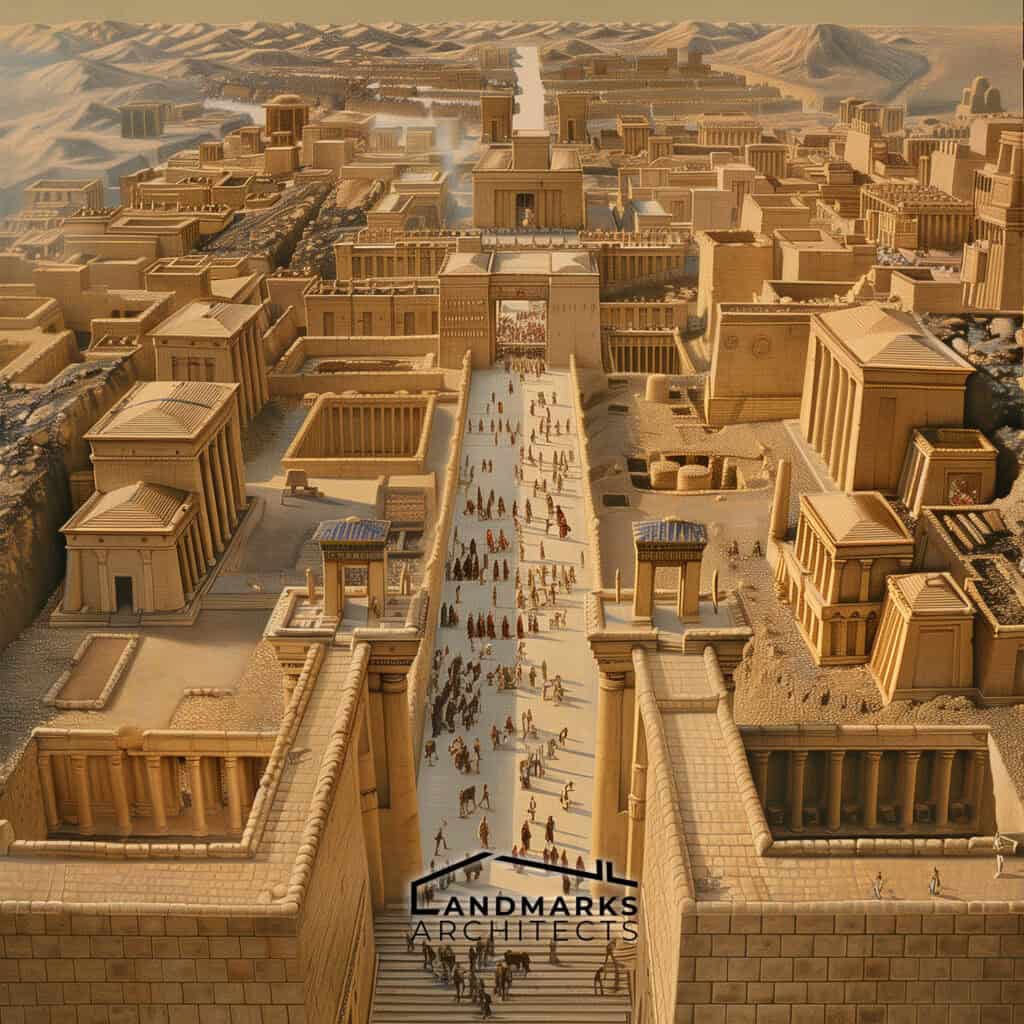
Urban planning was a defining feature of Mesopotamian cities, especially during the Uruk and Early Dynastic periods. Cities were meticulously laid out with wide streets, public buildings, and residential zones.
City walls, built from sun-baked or mud bricks, provided protection and delineated urban boundaries, facilitating trade and social interaction. Structures like Babylonian temples and royal palaces underscored the political and religious hierarchy, contributing to a well-organized society.
Decorative Arts
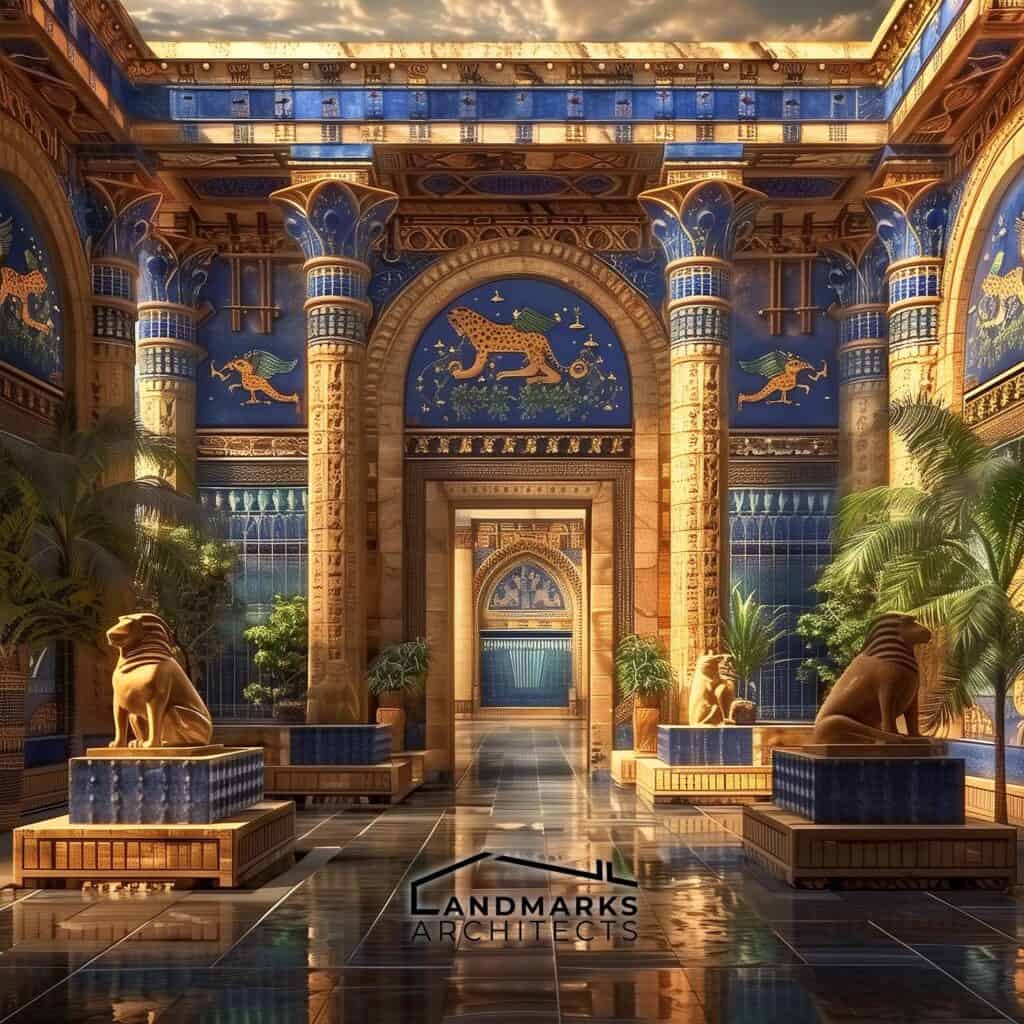
Decorative arts played a crucial role in Mesopotamian architecture. Temples and other buildings were adorned with colored stone, bas-reliefs, and intricate wall carvings depicting religious motifs and human figures.
Materials like lapis lazuli and hard stone were used to create stunning decorations, reflecting the power of the ruling class and their patron gods.
Notable Architectural Examples
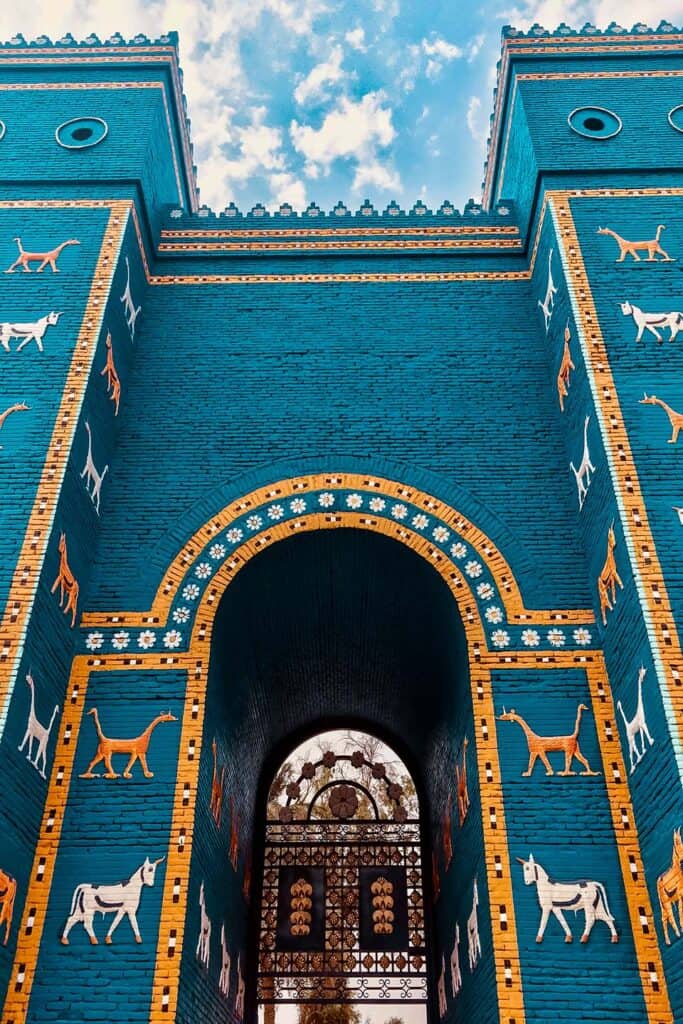
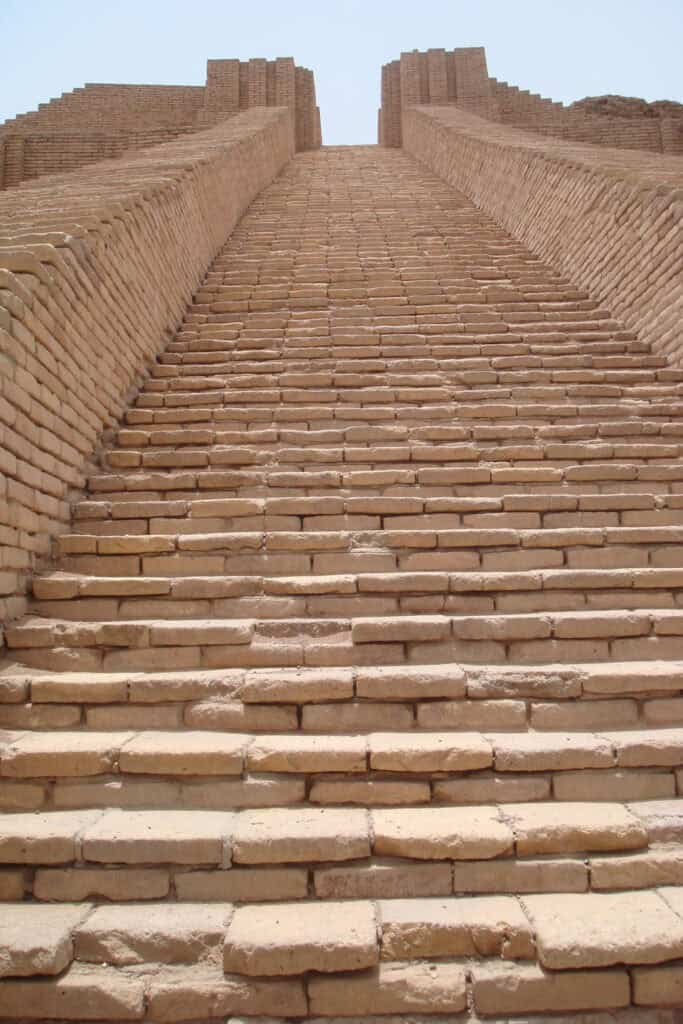
Ancient Mesopotamian architecture showcases monumental structures that reflect the civilization’s beliefs and urban planning. Significant examples include religious ziggurats, royal palaces, and grand city gates.
These structures reveal the sophisticated techniques and materials used by the Sumerians, Akkadians, Babylonians, and Assyrians.
The Ziggurat of Ur
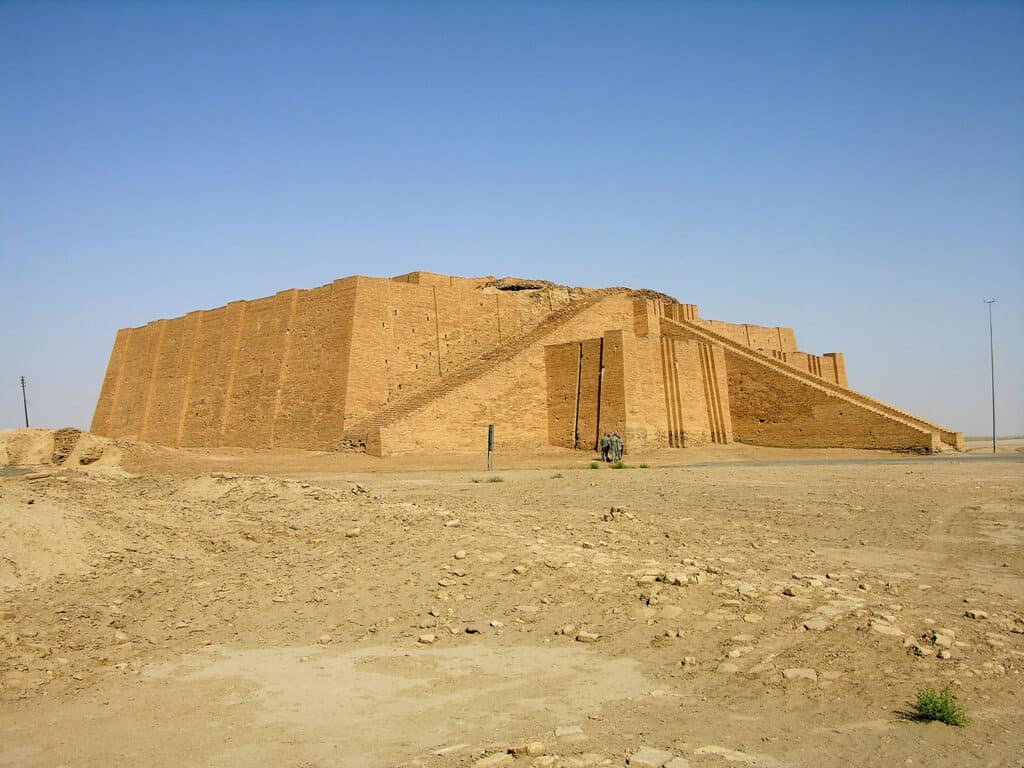
The Ziggurat of Ur, dating back to the Early Dynastic period, is one of the best-preserved examples of Mesopotamian architecture. Built primarily during the reign of King Ur-Nammu around 2100 BCE, it served as a temple complex dedicated to the moon god Nanna.
The structure features a massive base made of sun-dried mud bricks, reaching approximately 21 meters in height.
This ziggurat showcases the Sumerians’ advanced understanding of urban planning and construction techniques. Its three-tiered platform with a staircase that leads to a shrine exemplifies Sumerian monumental architecture. The site continues to provide valuable archaeological evidence of Sumerian religious practices and city layouts.
History of the Ziggurat of UrPalace of Sargon II
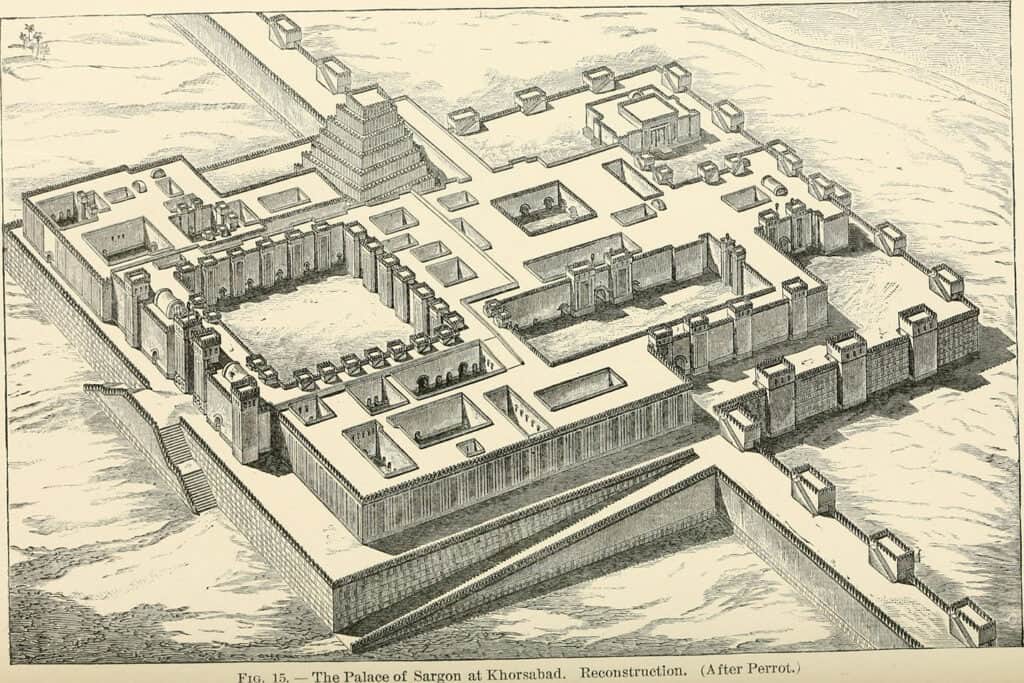

The Palace of Sargon II, located in Khorsabad, was built in the 8th century BCE and served as the royal residence for the Assyrian king Sargon II. Spanning over 5,000 square meters, the complex included administrative buildings, residential quarters, and exquisite gardens.
Notably, the palace exemplifies Assyrian architectural styles, with its grand entrance marked by colossal winged bulls adorned with intricate bas reliefs. These artworks depict Sargon’s military accomplishments and the patron deities of the Assyrian pantheon.
The use of mud bricks, along with lavish decorations, highlighted the wealth and power of the Assyrian empire, making it an essential site of Mesopotamian history.
Ishtar Gate and Babylon
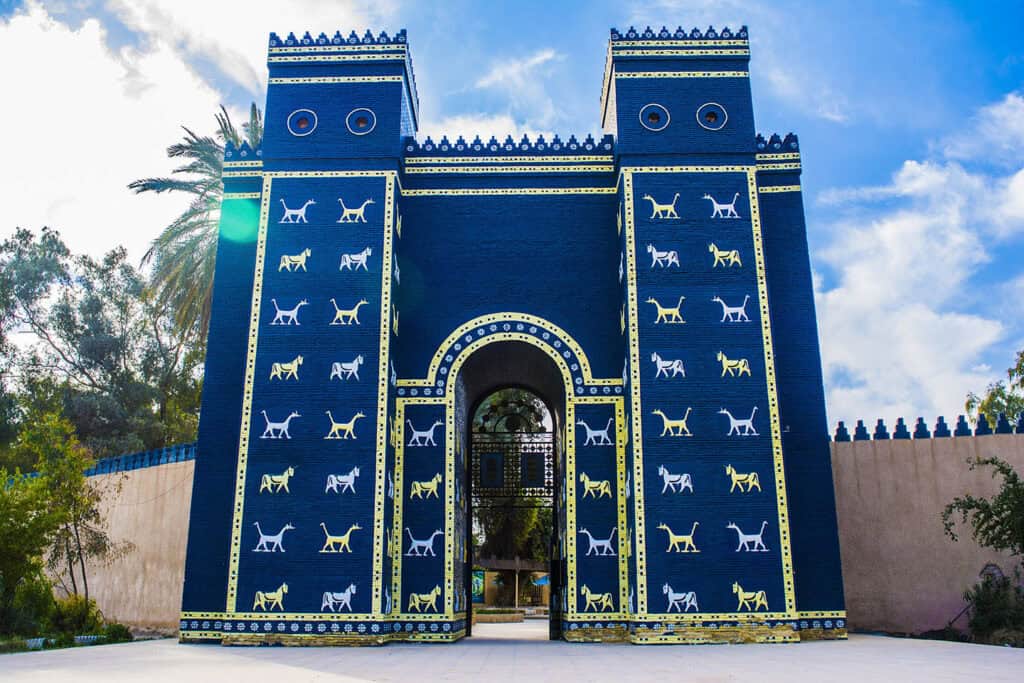

The Ishtar Gate, constructed during the reign of King Nebuchadnezzar II in the 6th century BCE, served as an entrance to the city of Babylon. This monumental structure is renowned for its stunning glazed brickwork, featuring vibrant blue tiles adorned with reliefs of dragons and bulls, symbolizing the patron deities Marduk and Ishtar.
The gate exemplifies Babylonian architecture’s focus on beautifying city entrances to impress visitors. It was part of a larger processional way that led to the grand temple complexes.
The craftsmanship of the Ishtar Gate reflects the sophisticated artistic techniques of the time, making it a significant piece of Mesopotamian culture.
Ancient Mesopotamian architecture: Recap
Ancient Mesopotamian architecture reflects a civilization’s ingenuity and cultural depth. From the awe-inspiring Ziggurat of Ur to the intricate Ishtar Gate, Mesopotamian builders utilized mud brick, arches, and elaborate decorations to shape their cities.
Their innovative techniques in urban planning and structural design laid a foundation for architectural advancements in the ancient world. These monumental structures not only served practical purposes but also embodied religious and political significance, leaving a lasting legacy on architectural history.
See Also Famous Buildings in Ancient Rome










